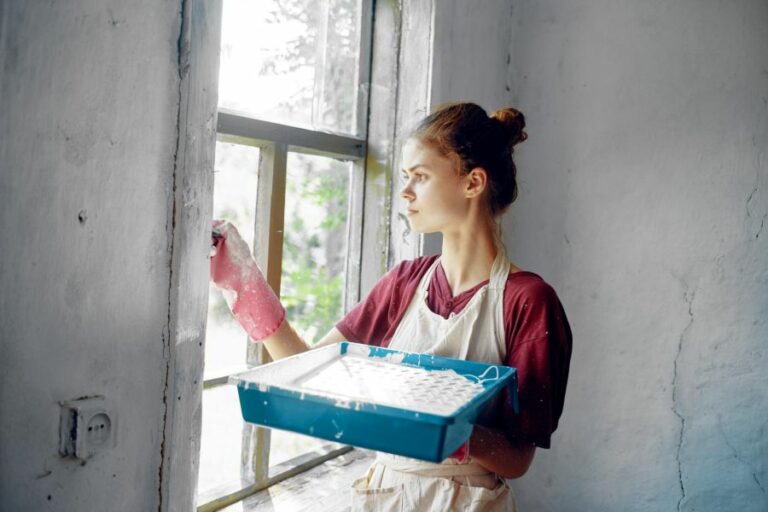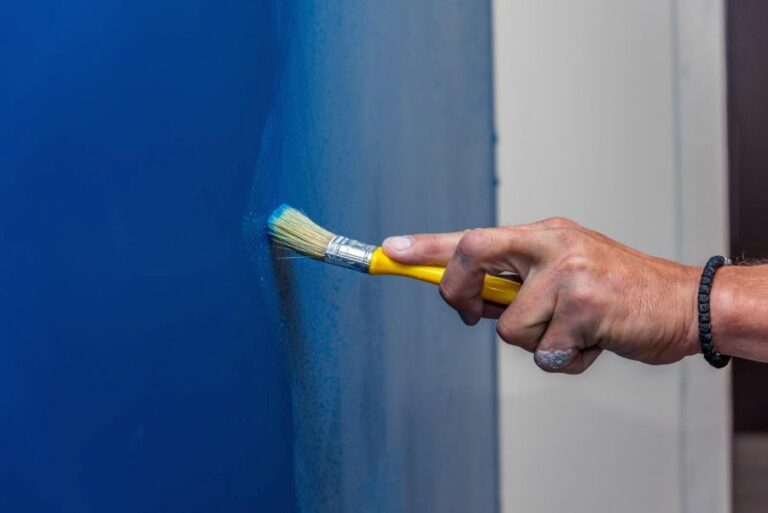Choosing Oil-Based Paints For Indoor Use. What Pros Say
If you’re looking to add a classic touch to your indoor space, oil-based paints could be the way to go. With their unmatched durability and rich hues, these paints offer a timeless finish that can elevate any room.
Choosing oil-based paints for indoor use:
Oil-based paints, known for their durability, smooth finish, and excellent adhesion, are suitable for indoor use, especially in high-traffic areas. When choosing oil-based paints, consider color retention, surface preparation, ventilation, drying time, and clean-up. Popular brands include Benjamin Moore, Sherwin-Williams, and Behr.

Are you considering oil-based paints for your indoor space? We’ve got you covered! Read on to learn the perks of oil paints, the best surfaces to apply them on, and expert tips to achieve a flawless finish. You don’t want to miss this comprehensive guide!
Contents
- 1 Opting for Oil-Based Paints for Interior Spaces
- 2 Evaluating Indoor Suitability of Oil-Based Paints
- 3 Understanding Drawbacks of Oil-Based Paints
- 4 Selecting the Ideal Interior House Paint
- 5 Essential Knowledge Of Oil-Based Paints Usage
Opting for Oil-Based Paints for Interior Spaces
When it comes to painting your home, choosing the right paint can make all the difference. Oil-based paints have been around for quite some time and offer several benefits for indoor use. They are often known for their excellent durability, coverage, and rich finish.
However, choosing the perfect oil-based paint for your specific requirements can be challenging.
• Advantages of Oil-Based Paints
Paints can be broadly categorized as either water-based or oil-based. While water-based paints have become more popular in recent years, oil-based paints still have some distinct advantages*.
– Durability
Oil-based paints are known for their ability to withstand wear and tear, making them a suitable option for high-traffic areas in your home. They are less susceptible to chipping, peeling, and scratching compared to water-based paints.
– Smooth Finish
Oil-based paints have a high level of pigments that provide a smoother, more even finish than water-based paints. As oil-based paints take longer to dry, this allows more time for the brush and roller marks to level out.
– Alkyd Resins
Oil-based paints contain alkyd resins, which offer better adhesion to the surface and help in forming a hard, glossy finish. This feature is especially advantageous when painting furniture or cabinets where a glossy finish is desirable.
• Factors to Consider When Choosing Oil-Based Paints
Knowing the advantages of oil-based paints is one thing, but understanding the crucial factors to consider when making your choice is vital for achieving your desired results.
– Color Retention
Over time, oil-based paints can tend to yellow or fade, especially when exposed to sunlight. If the area you are painting is prone to sunlight exposure, consider using a lighter shade of paint, as the yellowing effect will be less noticeable.
– Surface Preparation
Before applying oil-based paint, the surface should be adequately prepared. This typically includes cleaning, sanding, and priming the area. Consult the paint manufacturer’s guidelines for detailed preparation instructions specific to your chosen paint.
– Ventilation
Oil-based paints have a strong odor and contain volatile organic compounds (VOCs). Proper ventilation during and after painting is crucial to minimize the health risks associated with exposure to these compounds. Open windows and doors and use fans to circulate air when using oil-based paints.
– Drying Time
Compared to water-based paints, oil-based paints have a longer drying time. This can sometimes lead to a delay in completing your project, especially if multiple coats are required. Plan your painting schedule accordingly to avoid any inconvenience.
– Ease of Cleanup
Cleaning up after using oil-based paints can be quite challenging, as they are not water-soluble. You will need to use a solvent like mineral spirits or paint thinner for clean-up. Remember to dispose of these solvents responsibly, as they can harm the environment if not handled correctly.
• Brands and Recommendations
Several trusted paint manufacturers offer a wide range of oil-based paints for different applications. To help you with your paint selection, here are a few highly recommended oil-based paints from top manufacturers.
– Benjamin Moore
Benjamin Moore’s Satin Impervo and Regal are both high-quality alkyd enamel paints known for their excellent durability and smooth finish. They are ideal options for painting furniture, cabinets, and trim.
– Sherwin-Williams
Sherwin-Williams offers a range of oil-based paints for various applications, including interior walls, trim, and furniture. Their ProClassic Alkyd Interior Enamel and All Surface Enamel Oil Base are highly recommended for their superior durability and reliable coverage.
– Behr
Behr’s Alkyd Semi-Gloss Enamel paint combines the performance and durability of oil-based paints with the convenience of water-based paints. This makes it an excellent option for those looking for a semi-gloss finish on interior surfaces, including doors, trim, and cabinets.
In conclusion, oil-based paints offer several advantages for indoor use, such as durability, a smooth finish, and excellent adhesion. When selecting oil-based paints, consider essential factors such as color retention, surface preparation, ventilation, drying time, and clean-up.
Keep in mind the recommendations and insights provided in this article to select the perfect oil-based paint for your next indoor painting project.
Evaluating Indoor Suitability of Oil-Based Paints
There’s a long-standing debate among painters, contractors, and homeowners about which type of paint to use, especially when it comes to indoor applications. Oil-based paint, which has been around for many decades, is often compared to water-based or latex paint, a newer alternative.
• Advantages of Oil-Based Paint
– Durability and Longevity
One of the primary benefits of using oil-based paint is its durability. Oil paints are known for their resistance to wear and tear, since they form a hard, protective layer when they dry. Because of this, they’re less prone to chipping, peeling, and scratching.
In turn, this results in longer-lasting paint jobs that can save time and money in the long run.
– Smooth Finish
Oil-based paint is famed for its ability to deliver a smooth, even finish. Since it takes longer to dry than its water-based counterpart, it allows brush marks to level out and minimize imperfections. It results in a professional, polished appearance that’s desired by many homeowners and contractors alike.
– Adhesion Properties
Another notable advantage is the reliable adhesion of oil-based paints. They can bond with various surfaces, including those that may be harder for water-based paints to adhere to, such as melamine, ceramic tile, and even certain metals.
This makes oil-based paint an ideal choice for indoor projects like painting furniture, cabinets, or even doors and windows.
• Disadvantages of Oil-Based Paint
– Strong Odor and VOCs
With the advantages come the drawbacks. Undeniably, the most significant downside to oil-based paint is its strong odor. The solvents found in these paints release volatile organic compounds (VOCs) during and after application, which can lead to an unpleasant smell.
VOCs have also raised health and environmental concerns, as they contribute to poor indoor air quality and can cause breathing problems for people with asthma or other respiratory issues. As a result, many regions have imposed restrictions on oil-based paints to lower VOC emissions.
The Environmental Protection Agency (EPA) provides more information on VOCs and their potential impacts.
– Longer Drying Time
As mentioned earlier, oil-based paint takes longer to dry than water-based alternatives. While this can be beneficial for achieving a smooth finish, it may not be suitable for projects with tight time constraints or limited working areas where multiple coats are necessary.
– Cleanup
Cleaning brushes and other painting tools used with oil-based paint require solvents, such as mineral spirits or paint thinner. This can be inconvenient and potentially harmful to the environment, while water-based paints only require water for cleanup.
– Yellowing
Oil-based paint’s resistance to wear and tear can have an unintended consequence: yellowing over time. This can create an aged appearance, especially on white or light-colored surfaces.
0While this isn’t a concern for all indoor applications, it’s worth considering when painting areas like baseboards, trim, and doors.
• Choosing the Right Paint for Your Indoor Project
When deciding if oil-based paint is the right choice for your indoor project, consider the following factors:
- The surface you’re painting and its required durability
- Your timeline and need for multiple coats
- The paint’s impact on indoor air quality and your health
- Cleanup and environmental considerations
If you value durability, adhesion, and a smooth finish, oil-based paint may be a suitable choice for your indoor project. However, be prepared for the strong odor, longer drying time, and potentially toxic VOCs.
In recent years, advancements in water-based paint technology have led to options with similar performance to oil-based paints while offering lower odor and easier cleanup. For this reason, I recommend exploring low or zero-VOC latex paints as an alternative.
Ultimately, carefully weigh the advantages and disadvantages of oil-based paint to determine if it’s the best fit for your indoor painting needs.
Understanding Drawbacks of Oil-Based Paints
– Difficulty in Cleanup
One major disadvantage of oil-based paint is the difficulty in cleaning and disposing of paint from your tools, equipment, and surfaces. Oil-based paint is not water-soluble, which means that it requires paint thinner or mineral spirits to clean up.
This can be time-consuming and may expose you to hazardous fumes. In addition, the cleanup process often produces hazardous waste which should be disposed of properly by following your local regulations.
The United States Environmental Protection Agency (EPA) provides proper disposal guidelines for these materials.
– Longer Drying Time
Oil-based paint takes a long time to dry in comparison to water-based paint or latex paint. It usually takes 24 hours or more to dry completely, depending on the brand and environmental conditions.
This longer drying time can be a significant inconvenience for homeowners and contractors, as it may cause delays in the completion of projects, and you have to wait longer before applying a new coat of paint.
– Environmental and Health Concerns
Oil-based paint contains high levels of volatile organic compounds (VOCs), which can be harmful to both the environment and human health. VOCs are emitted as the paint dries and during the application process.
These VOC emissions can contribute to air pollution, while indoor exposure to VOCs can lead to health issues such as headaches, dizziness, and respiratory problems.
Additionally, oil-based paint often contains heavy metals like lead, which can be toxic, especially to children. Due to these concerns, the use of oil-based paints has significantly decreased in recent years, and many countries now favor environmentally-friendly latex and water-based paints.
– Reduced Flexibility
Oil-based paint tends to become more brittle with time, which can lead to cracking and chipping. This lack of flexibility can be particularly problematic in areas with fluctuations in temperature and humidity, as the paint may not be able to withstand the stress, causing the surface to deteriorate.
In contrast, water-based paints offer more flexibility and tend to hold up better in changing conditions.
– Limited Color Options
With the growing shift towards environmentally-friendly paint options, many manufacturers have reduced their production of oil-based paints. This reduction has resulted in a decreased range of color options available for consumers.
Furthermore, oil-based paint colors may be more likely to fade and discolor over time.
– Poor Shelf Life
If you store your leftover oil-based paint for too long, it can become lumpy or solidify, making it unusable for future use. This is because the oil in the paint can separate, causing the paint to thicken and harden.
On the other hand, water-based paints tend to maintain their consistency and usability when stored properly.
– More Expensive
In general, oil-based paints are more expensive than water-based or latex paints. This is due to the higher cost of the ingredients used in oil-based paint, which also contributes to the higher VOC levels.
Considering the drawbacks of oil-based paints and the availability of more affordable and environmentally-friendly alternatives, the higher cost of oil-based paints is an important disadvantage to consider.
– Application Challenges
Applying oil-based paint can be more difficult compared to water-based paint. Due to its thicker consistency, oil-based paint requires a more careful application to achieve a smooth and even finish.
Moreover, it is more likely to show brush strokes and may display an uneven sheen if not applied properly. Furthermore, oil-based paint is known for having a potent smell, which may be unpleasant to some and may necessitate increased ventilation during application.
• In Conclusion
In summary, the disadvantages of oil-based paint make it a less attractive option for many homeowners and contractors.
The difficulty in cleanup, longer drying time, environmental and health concerns, reduced flexibility, limited color options, poor shelf life, higher cost, and application challenges are all factors to consider when deciding between oil-based and water-based paint options.
Based on these disadvantages, I recommend exploring latex or water-based paint alternatives, which are more environmentally friendly, easier to apply and clean, and more cost-effective.
| Disadvantages of Oil-Based Paint | |
|---|---|
| 1. Long drying time | Oil-based paints can take a long time to dry, sometimes up to 24 hours or more. |
| 2. Strong odor | Oil-based paints produce a strong and lingering odor during and after application. |
| 3. Harmful chemicals | These paints may contain harmful chemicals like volatile organic compounds (VOCs), which can cause respiratory issues and other health problems. |
| 4. Environmental concerns | The use of oil-based paints may contribute to air pollution and other environmental issues due to the release of VOCs. |
| 5. Difficult cleanup | Cleaning tools and surfaces after using oil-based paint can be difficult and may require the use of solvents like mineral spirits or paint thinner. |
| 6. Yellowing over time | Oil-based paints, especially white or lighter shades, can yellow or discolor over time due to exposure to sunlight, heat, and humidity. |
| 7. Flammability | These paints are more flammable than water-based paints, posing a potential fire hazard during storage and application. |
Selecting the Ideal Interior House Paint
Transforming the look of a home with a fresh coat of paint is a project countless individuals embark upon each and every year. Naturally, the question of which paint to use arises quite frequently.
• Acrylic and Latex: The Superior Choice for Interior Walls
Paints are primarily categorized into two types: oil-based and water-based. For interior walls, we strongly recommend opting for water-based paints, specifically acrylic or latex. These types of paint possess a multitude of benefits over their oil-based counterparts.
– Advantages of Acrylic and Latex Paint
- Easy Cleanup: Acrylic and latex paints are both water-based. This makes cleaning up after the painting job is completely a breeze. All you need is water and perhaps some mild soap to clean your brushes and rollers.
- Low Volatile Organic Compounds (VOCs): VOCs are harmful chemicals released from certain products, including paint. Water-based paints contain a significantly lower amount of VOCs, making them a much safer choice for indoor use. In recent years, we’ve seen the introduction of Low-VOC and even Zero-VOC paints for those particularly concerned about air quality. The EPA provides an excellent resource on VOCs in paint and how to minimize exposure.
- Quick Drying Time: Acrylic and latex paints dry much faster than oil-based paints, which means rooms can be put back to use much more rapidly.
- Long-lasting Durability: Water-based paints, particularly high-quality acrylics, offer exceptional durability, resisting chipping, peeling, and fading. This results in a longer-lasting paint job and less maintenance over time.
- Color Retention: Acrylic and latex paints tend to maintain their color better, especially in areas exposed to sunlight, mitigating the need for more frequent repainting due to fading.
– Disadvantages of Acrylic and Latex Paints
- Surface Preparation: Both acrylic and latex paints require thorough surface preparation. This includes cleaning the walls of dirt, dust, and grime, repairing cracks and holes, as well as priming in order for the paint to adhere properly.
- Can’t Be Applied Over Oil-Based Paint: If your walls currently have oil-based paint, acrylic or latex paints won’t adhere well without proper priming or removal of the existing paint.
• Selecting the Sheen: A Guide to Finishes
When choosing interior paint, it’s crucial to also consider the level of sheen or finish. There are several finishes to choose from, each with its own set of benefits.
– Flat or Matte Finish
A flat or matte finish provides a subtle, non-reflective appearance that can effectively hide minor surface imperfections. Due to its low sheen, this finish is best suited for low-traffic areas or rooms where a more subdued aesthetic is desired.
– Eggshell Finish
Eggshell finishes possess a slight sheen, providing a soft, velvety appearance. They offer a level of washability and stain resistance, which makes them ideal for rooms such as living rooms and bedrooms.
– Satin Finish
A satin finish has a slightly glossy surface, providing good washability and durability. Additionally, satin finishes tend to be more resistant to mildew and moisture, making them an excellent choice for high-traffic areas like hallways, entryways, and children’s rooms.
– Semi-Gloss Finish
Semi-gloss finishes are durable and easy to clean, with a noticeable sheen. Because of their increased durability, these are ideal for rooms where moisture and humidity may be present, such as kitchens, bathrooms, and laundry rooms.
– Gloss Finish
A gloss finish offers the highest level of sheen and durability; however, it also highlights surface imperfections. Glossy finishes are typically reserved for trim, doors, cabinets, and other architectural accents.
• Top Interior Paint Brands Worth Considering
Now that we’ve established the best type of paint and finishes for your home, here are our top recommendations for interior paint brands:
- Benjamin Moore Regal Select: Known for its long-lasting durability and excellent color retention, this is an excellent choice for interior walls.
- Sherwin-Williams Cashmere: This paint offers a luxurious, silky finish and superior coverage, ideal for both novice and experienced painters.
- Behr Marquee: A cost-effective, high-quality paint with a comprehensive range of colors and finishes to choose from.
- Valspar Signature: With excellent coverage, a wide variety of finishes, and an extensive color palette, this paint is an excellent choice for any home.
• Final Thoughts
In summary, the best paint to use inside your house is acrylic or latex-based paint with a finish that matches the intended purpose and aesthetic of the room. Opting for high-quality brands like Benjamin Moore, Sherwin-Williams, Behr, or Valspar will ensure a beautiful, long-lasting result.
With careful planning, diligent surface preparation, and the right paint and finish, you’ll be well on your way to creating a stunning transformation within your home.
Paint Type | Advantages | Disadvantages |
|---|---|---|
Water-Based Paint | Low VOCs, easy clean up, quick drying, resistant to mold and mildew, maintains color over time | Less durable compared to oil-based paint, may require multiple coats for coverage |
Oil-Based Paint | High durability, excellent leveling properties (smooth finish), covers surfaces well with fewer coats | Higher VOCs, longer drying time, harder to clean up, may yellow over time |
Latex Paint | A type of water-based paint, easy clean up, quick drying, environmentally friendly, maintains color over time | May require multiple coats for coverage, less durable compared to oil-based paint |
Acrylic Paint | Water-based, high durability, resistant to cracks and chipping, low odor, maintains color over time | May require multiple coats for coverage, higher cost compared to other water-based paints |
Essential Knowledge Of Oil-Based Paints Usage
Oil-based paint, also known as solvent-based or alkyd paint, has been a popular choice for various applications in residential and commercial projects. Its unique characteristics provide numerous benefits, such as durability and a high-quality finish.
• Understanding the Properties of Oil-Based Paint
– Composition
Oil-based paint is comprised of pigment, binder, and solvent. The pigment is responsible for the paint’s color, while the binder, typically a modified or natural oil, ensures the paint sticks to the surface upon application.
Lastly, the solvent, which is typically a petroleum-based product, serves to thin the paint and allows for smoother application.
– Drying Time
One of the most noticeable characteristics of oil-based paint is its slow drying time. This property can be both advantageous and disadvantageous, depending on the specific needs of a project. The slow drying process allows for better leveling, reducing visible brush marks and resulting in a smoother finish.
Additionally, this feature provides adequate time for the paint to be manipulated or blended before it dries completely. On the other hand, extended drying times can delay subsequent steps in a project, particularly in cases where multiple coats are required.
– Durability
Oil-based paint is known for its high durability, making it an excellent choice for high-traffic areas, exteriors, and surfaces that require frequent cleaning. The binder in oil-based paint ensures a strong bond with the surface, providing resistance to chipping, fading, and wearing.
Furthermore, oil-based paint offers excellent water and moisture resistance, making it suitable for rooms with high humidity levels, such as bathrooms and kitchens.
• Applications of Oil-Based Paint
– Suitable Surfaces
Oil-based paint adheres well to a variety of surfaces, including wood, metal, and masonry. Notably, it’s particularly effective on surfaces that have been previously painted with oil-based products.
However, it is essential to ensure the surface is well-prepared, clean, and free of any loose paint, rust, or other contaminants before application.
– Trim and Moldings
One of the most common uses of oil-based paint is on trim, baseboards, door casings, and moldings due to its excellent durability and high-quality finish.
Oil-based paint provides a hard, smooth surface that is less likely to collect dirt and dust, and it’s more resistant to scuffing and chipping than water-based paint.
• Proper Application of Oil-Based Paint
– Priming
It is crucial to start with a proper primer when using oil-based paint, particularly on new or bare surfaces. A primer not only provides a uniform base for the paint to adhere to but also enhances the paint’s durability and longevity. For the best results, opt for an oil-based primer compatible with the chosen paint.
– Ventilation
Working in a well-ventilated area is essential when using oil-based paint, as the fumes can prove to be hazardous when inhaled in large quantities. Ensure that the space has adequate airflow by opening windows and doors, using exhaust fans, or employing air filtration systems if necessary.
It’s also important to follow safety guidelines, such as wearing a mask and protective eyewear, to prevent exposure to harmful vapors.
– Cleanup
Cleaning up after using oil-based paint requires special attention, as water alone is not sufficient to dissolve the paint. Instead, use a paint thinner or mineral spirits to clean brushes, rollers, and other equipment.
Furthermore, proper disposal of oil-based paint and associated materials is crucial, as they are considered hazardous waste. Check with your local waste facility for proper disposal methods and regulations.
• Drawbacks of Oil-Based Paint
– Environmental Concerns
One of the most significant disadvantages of oil-based paint is its environmental impact. The solvents in the paint release Volatile Organic Compounds (VOCs) during the drying process, which can lead to air pollution and potential health hazards.
As such, many regions enforce regulations limiting the VOC content in paints or promoting the use of low-VOC alternatives, such as water-based latex paint.
– Yellowing
Over time, oil-based paint tends to turn yellow, particularly when subjected to limited light exposure or in areas with infrequent use. This discoloration occurs primarily due to the natural oxidation of the oil content, and while this process may take years, it can detract from the overall aesthetics of a space.
In conclusion, oil-based paint offers an array of benefits, with its durability and high-quality finish making it a viable option for various projects involving wood, metal, and masonry surfaces.
However, it’s essential to consider the potential drawbacks, such as the extended drying times, environmental impact, and susceptibility to yellowing. For further information on oil-based paint and proper application techniques, consult resources from authoritative sources like the US EPA.







